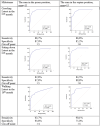The qualitative motor assessment at three months allows a better prognosis than the traction test
- PMID: 40301428
- PMCID: PMC12041512
- DOI: 10.1038/s41598-025-98118-5
The qualitative motor assessment at three months allows a better prognosis than the traction test
Abstract
The study was conducted prospectively on 107 children (74 boys). Eighty-three children were born at term (39 ± 1), 24 were born prematurely (33 ± 4). The study included the qualitative assessment at three months of age, eye contact and traction response assessment, and the quantitative assessment at 3, 9, and 16 months of age. The timely achievement of crawling and sitting down depended on the same qualitative characteristics at three months of age: hands and lower limbs and on the segmentally extended spine and shoulder blades. Social walking was influenced by the qualitative assessment of the position of the lower limbs at three months of age. The eye contact substantially impacted walking; the correct traction test moderately impacted crawling and sitting down. The qualitative assessment at three months is highly predictive for crawling and sitting down at nine months and social walking at 16 months. The correct traction test appears to predict crawling and sitting down, while eye contact is essential for social walking.
Keywords: Eye contact; Milestone; Qualitative assessment; Traction test.
© 2025. The Author(s).
Conflict of interest statement
Declarations. Competing interests: The authors declare no competing interests.
Figures
Similar articles
-
Qualitative assessment in the third month of life allows for a better prognosis of the achievement of motor milestones versus assessment of pathological reflexes- prospective studies on Polish children.Front Public Health. 2023 Sep 14;11:1253137. doi: 10.3389/fpubh.2023.1253137. eCollection 2023. Front Public Health. 2023. PMID: 37780436 Free PMC article.
-
Independent reaching of the sitting position depends on the motor performance in the 3rd month of life.Eur Rev Med Pharmacol Sci. 2015;19(2):201-8. Eur Rev Med Pharmacol Sci. 2015. PMID: 25683931
-
Variations in early gross motor milestones and in the age of walking in Japanese children.Pediatr Int. 2011 Dec;53(6):950-5. doi: 10.1111/j.1442-200X.2011.03423.x. Pediatr Int. 2011. PMID: 21752149
-
Pediatric cervical kyphosis in the MRI era (1984-2008) with long-term follow up: literature review.Childs Nerv Syst. 2022 Feb;38(2):361-377. doi: 10.1007/s00381-021-05409-z. Epub 2021 Nov 22. Childs Nerv Syst. 2022. PMID: 34806157 Review.
-
Gait Characteristics of Children Born Preterm.Neoreviews. 2019 Jul;20(7):e397-e408. doi: 10.1542/neo.20-7-e397. Neoreviews. 2019. PMID: 31261106 Review.
References
-
- Adolph, K. E. & Hoch, J. E. The Importance of Motor Skills for Development. in Nestlé Nutrition Institute Workshop Series (eds. Black, M. M., Singhal, A. & Hillman, C. H.) vol. 95 136–144 (S. Karger AG, (2020). - PubMed
MeSH terms
LinkOut - more resources
Full Text Sources
Medical



